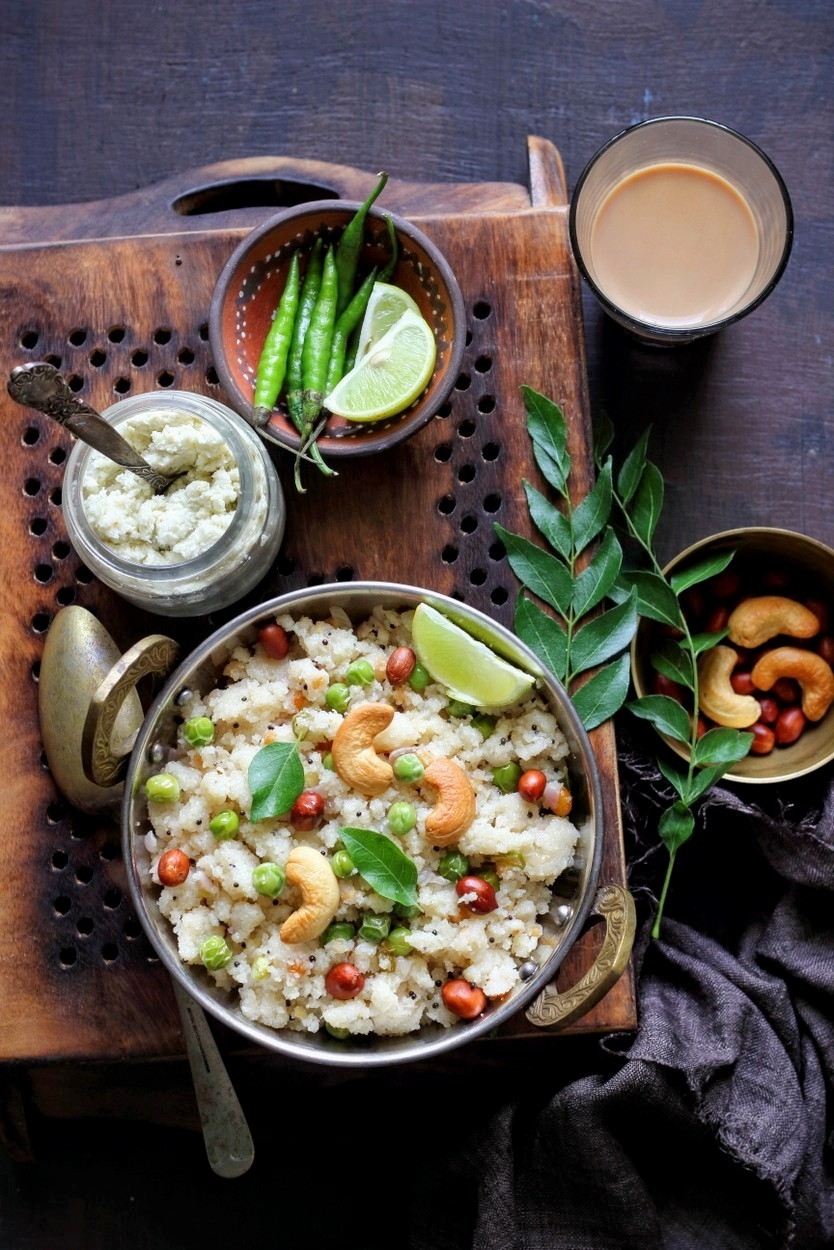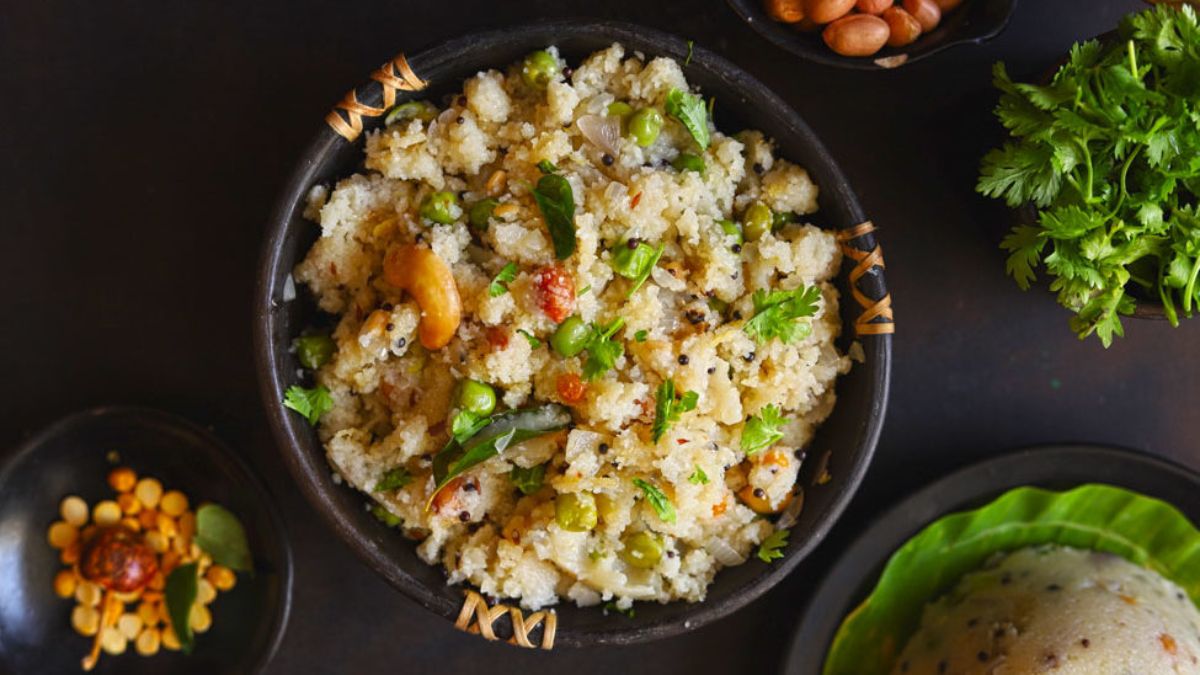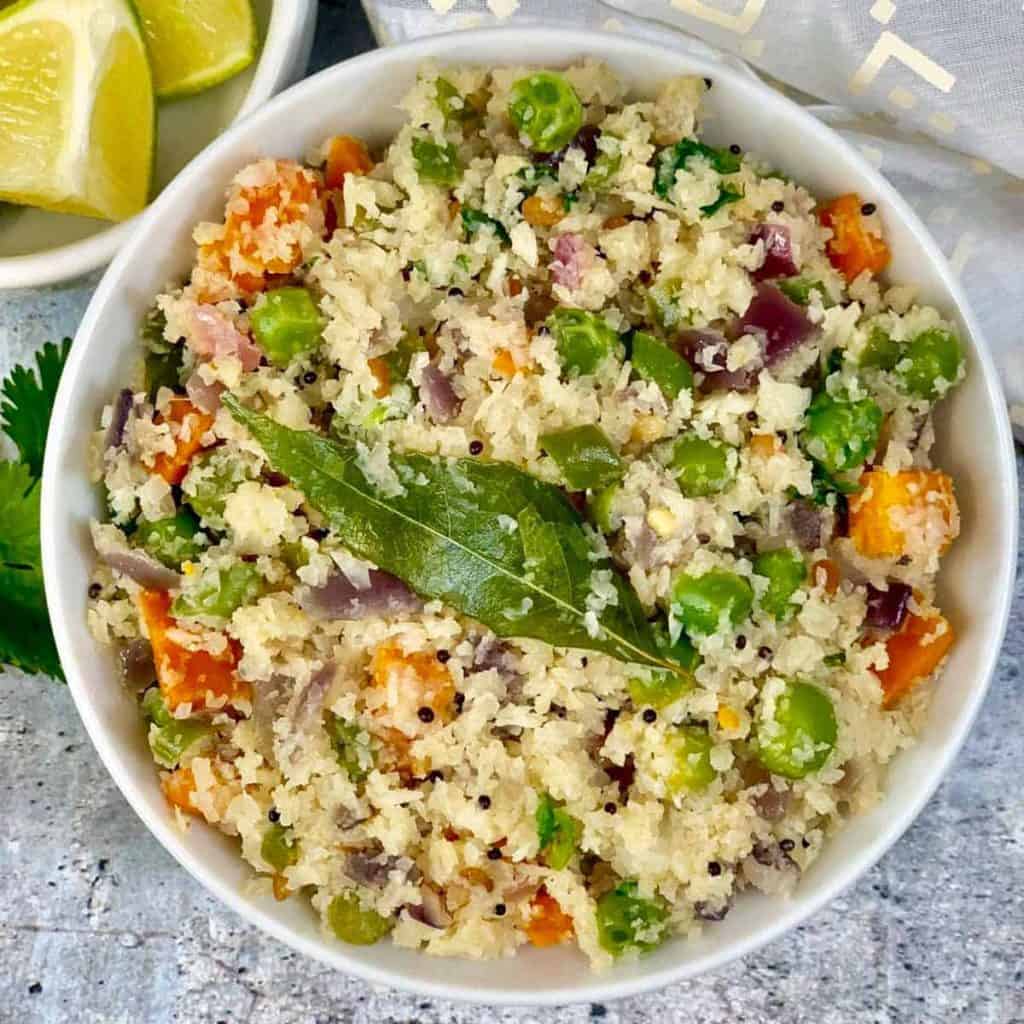Upma, a classic dish hailing from the southern regions of India, is a comfort food savored not just for breakfast but also as a hearty snack that fits into any part of the day. This savory semolina porridge is both modest in its ingredients and rich in flavors, making it much more than an ordinary meal—it’s a warm hug served on a plate.
Crafted with precision, upma begins with roasted rava or semolina, which is then bathed in a nurturing pool of water or sometimes broth, gently cooked to a soft yet substantial consistency. The real alchemy occurs when this simple base is enlivened with a vibrant chorus of mustard seeds, fresh curry leaves, fragrant ginger, piquant green chilies, and sweet-savory onions, all sizzling together in hot oil.
Upma Savory Semolina Porridge Recipe


Upma Savory Semolina Porridge
Equipment
- 1 large skillet
Ingredients
- 1 tablespoon coconut oil
- 1/2 teaspoon mustard seeds
- 1 teaspoon husked whole black lentils
- 1 teaspoon Bengal gram
- 2 green chiles finely chopped
- 1 teaspoon asafoetida
- 1 curry leaf sprig
- 2 cups water
- 11/4 teaspoons salt
- 1 tablespoon plain Greek yogurt
- 1 cup roasted semolina or upma mix
- 1 teaspoon finely chopped fresh dill
- 1 teaspoon ghee
- Coconut Chutney for serving
Instructions
- In a large skillet over medium heat, heat the coconut oil.
- Add the mustard seeds, black lentils, and Bengal gram. Cook until the mustard seeds begin to sputter, about 1 minute.
- Add the green chiles, asafoetida, and curry leaves. Cook for 45 seconds.
- Add the water and salt. Bring the water to a rolling boil and stir in the yogurt.
- Reduce the heat to medium-low and slowly add the semolina, stirring constantly to avoid lumps. Once all the semolina is added, stir vigorously to avoid lumps and achieve a consistent texture throughout. Partially cover the skillet and cook for 2 minutes.
- Turn off the heat. Stir in the dill and ghee, mixing thoroughly. Partially re-cover the skillet and let sit for 5 minutes. Serve hot with coconut chutney.
Notes
Cooking Tips about Upma Savory Semolina Porridge

- Roast the Semolina: Begin by dry roasting the rava or semolina until it’s golden and aromatic. This crucial step imparts a nutty flavor and prevents the upma from becoming sticky or lumpy.
- Use Ghee for Flavour: For an authentic taste and a lovely aroma, cook the mustard seeds, curry leaves, and other spices in ghee. If you’re vegan, you can opt for oil, but ghee does add an irreplaceable richness.
- Water to Semolina Ratio: Maintain a water to semolina ratio of about 2:1 or 2.5:1 to ensure that your upma is moist and fluffy, not too dry or too gooey.
- Cook on Low Heat: Once the water is added to the roasted semolina, cook the mixture on low heat. This allows the semolina to absorb the water evenly and swell up, resulting in a soft texture.
- Keep Stirring: Stir continuously after adding the semolina to the boiling water to avoid any lumps and ensure even cooking.
- Personalize with Vegetables: Feel free to add diced carrots, peas, bell peppers, or any vegetables of your choice to the upma. Adding vegetables not only makes it healthier but also adds color and variety to the dish.
- Finish with Freshness: Garnish the upma with fresh coriander leaves and a squeeze of lemon juice just before serving. This will give it a refreshing zing.
- Serve Hot: Upma tastes best when served hot, as it tends to thicken and lose its softness as it cools down.
Serving suggestions about Upma Savory Semolina Porridge

- Coconut Chutney: A classic sidekick to upma, coconut chutney brings a creamy texture and a subtle sweetness that complements the earthiness of the semolina.
- Sambar: Pour a ladleful of sambar— a tangy lentil-based vegetable stew—over your upma for a flavor-packed South Indian experience.
- Pickles: A small spoonful of Indian pickle, known for its spicy and tangy taste, can give your upma an exciting flavor burst.
- Fried Cashews or Peanuts: Sprinkle roasted cashews or peanuts on top for an added crunch that contrasts the softness of the upma.
- Yogurt: A dollop of plain yogurt or a side of raita (yogurt mixed with vegetables and spices) can cool the palate and provide a refreshing counterpoint to the warm porridge.
- Fresh Coriander and Lemon: Garnish with chopped fresh coriander leaves and serve with a wedge of lemon to squeeze over the upma, adding zest and brightness.
- Papad: Serve crispy papad (thin, crisp disc-shaped Indian food) on the side for an additional textural element that’s beloved across India.
- Sev: A sprinkling of sev (crunchy noodle-like snack made from chickpea flour paste) can add a fun twist, giving each bite a pop of crunchiness.
Top 5 FAQs about Upma Savory Semolina Porridge

- What is Upma? Upma is a traditional Indian dish from the southern regions known for its warm and comforting qualities. It’s a savory semolina porridge that combines roasted rava (semolina) with a variety of spices, vegetables, and sometimes nuts. It’s commonly enjoyed as a hearty breakfast or snack.
- How do you make Upma moist and fluffy? To ensure your Upma has the perfect consistency, maintain a water to semolina ratio of about 2:1 or 2.5:1. Start by roasting the semolina to a golden brown to bring out a nutty flavor and prevent stickiness. Once you add the water, cook the mixture on low heat and keep stirring to allow the semolina to absorb the water evenly, making it moist and fluffy.
- Can I add vegetables to Upma, and if so, which ones work well? Absolutely! Upma welcomes the addition of various vegetables adding both nutritional value and bursts of color. Commonly used veggies include diced carrots, peas, bell peppers, and onions. Feel free to add any of your favorite vegetables to personalize the dish.
- What are some traditional accompaniments served with Upma? Traditional sides include coconut chutney, which adds creaminess and a touch of sweetness; sambar, a tangy lentil-based vegetable stew for a hearty pairing; spicy Indian pickles for a taste kick; and a dollop of plain yogurt or raita to cool down the palate. You can also garnish with fresh coriander leaves, squeeze lemon juice over the top for freshness, or add crunchy elements like fried cashews or sev.
- Is there a vegan option for making Upma? Yes, while ghee is traditionally used for its rich flavor, vegans can substitute it with oil to fry the spices and vegetables. Ensure that all other ingredients like broth are also vegan-friendly if choosing not to use water. Moreover, Upma can be tailored to meet dietary preferences without compromising on taste.
As we reach the final stir of our upma journey, it’s clear that this traditional Indian dish is more than just sustenance; it’s a celebration of flavors and textures that bring comfort to any table. Upma stands as a testament to the beauty of simplicity in cooking—a dish that starts with humble semolina and transforms, with care and creative flair, into a wholesome and satisfying meal that conjures the essence of homely Indian cuisine.

Leave a Reply